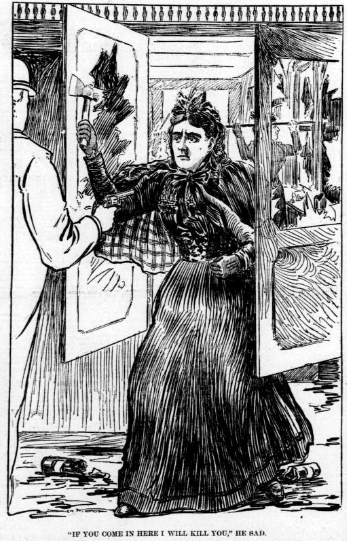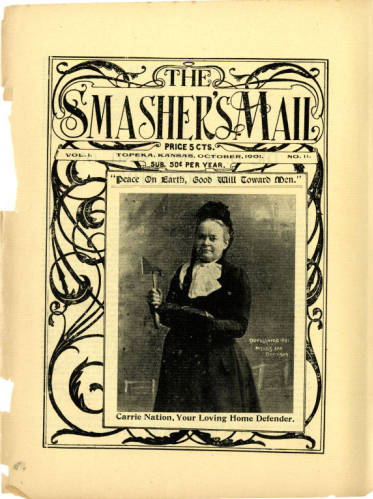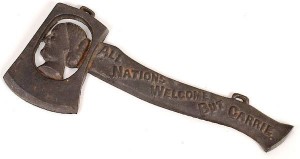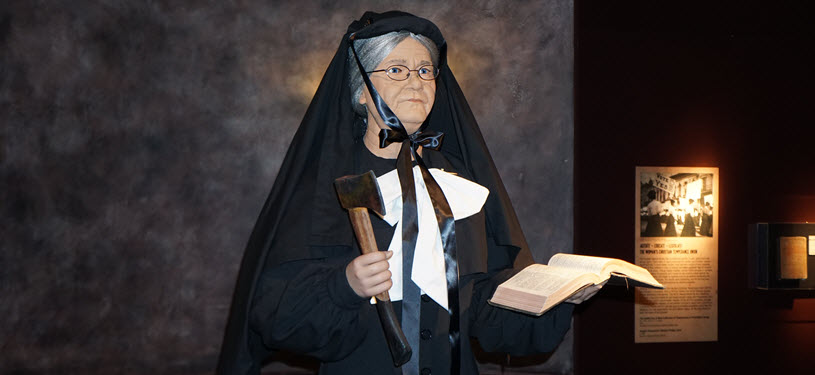
Accurately described as “A six foot tall stevedore with the face of a prison warden and the persistence of a tooth ache”, Kentucky born blue blood Mrs. Carrie Amelia Moore Nation – aka ‘The Joint Smasher’ became a radical member of the Midwest temperance movement after losing her first husband to the bottle in 1869. Proudly describing herself as “A bulldog running at the feet of Jesus, barking at what he doesn’t like”; she was indeed that and many things more.
Carrie A. Nation for Prohibition
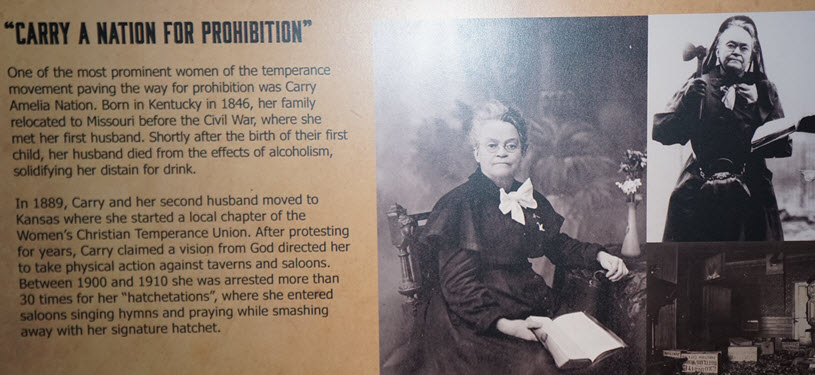

In 1901 driven by a holy message delivered to her in her sleep, Carrie fell into a self-described hatchetation entering a local blind tiger by the name of the Senate Bar in Topeka, Kansas and laying waste to the venue with a hatchet. Mrs Nation succeeded in smashing kegs, bottles, mirrors, the cash register, refrigerator, slot machines, beer taps and even the beer lines before finally being arrested by local authorities. Despite alcohol having been banned in the state of Kansas since 1881 (39 years before the 18th amendment would bring prohibition to the country) Carrie confessed she was driven by a divine voice to help save these men from a drunkards fate within venues she bluntly termed “Murder Shops”.
Stay Informed: Sign up here for our Distillery Trail free email newsletter and be the first to get all the latest news, trends, job listings and events in your inbox.
The road to the hatchet however was a somewhat progressive one beginning simply with verbal demands of closure directed at the illegal bar owners in her local town of Kiowa, Kansas. With her warnings not surprisingly falling upon deaf ears and yet empowered with a sense of divinity, Carrie described her next steps as such;
“I wrapped up my rocks, and I didn’t dare to tell a human being what I was about to do”.
~Carrie A. Nation
Entering again one of the saloons, which had been pre-warned, she confidently set about throwing her carefully wrapped rocks at anything fragile within range before leaving the saloon with a mosaic of broken glass and stunned patrons in her wake. This however, was just the beginning. Inspired by a throw away comment from her then husband to “use a hatchet for maximum damage” – less than a month later Carrie would continue her rampage, iconic axe in hand, wrecking havoc upon a further four saloons, three mirrors, 211 glasses and bottles and 26 gallons of beer and whiskey. By the end of the next month, supported by some conscripts from the WCTU (Women’s Christian Temperance Union) a further two towns, three saloons, three mirrors, 175 bottles and 35 gallons of beer and whiskey would be added to her tally. If a door was barred she would simply go at it with the hatchet. Carrie did not go unscathed herself however; despite being bloodily assaulted on more than one occasion by saloon patrons, threatened with a pistol and arrested multiple times including a stint of 21 days in a Wichita jail, the Joint Smasher would not be deterred from her spiritual duty.
When asked by a reporter how she could justify the destruction of property Carrie answered with apparent clenched fists and flashing eyes, “Young man, if you should see two men with deadly weapons, engaged in mortal combat, would it not be your plain duty to take those weapons from them? That is exactly what I do when I destroy the saloons. I am taking away the weapon with which our fathers, our brothers and our boys are being murdered…it is right when all methods recognized by law have proved dismal failures.”
Needless to say these extreme acts of divine duty, whether publicly supported or not, made Carrie a living icon with her exploits serving popular fodder for newspapers all over the country. In a political environment already heavily pressured by temperance groups, Carrie and her hatchet quickly became a symbol of the abolition movement. And so began her travels around the country giving speeches and urging fellow believers to join in her hatchetations. Adopting the name “Carry A. Nation” to her cause for to its value as a rousing slogan, Carrie even had it registered as a trademark in the state of Kansas to help legitimise her purpose. To yet further promote public awareness Carrie published her own bi-weekly newsletter aptly entitled “The Smashers Mail” while also hawking signed photographs and miniature hatchets to her adoring followers.
It was not long until other budding smashers took up the proverbial hatchet in support of temperance such as Mrs. Thomas from Leavenworth, Kansas who was reported in a local newspaper in 1901;
“…seized an armful of bricks and stormed a joint operated by Martin Fitch in a shanty. Her first volley crashed through a window and was the signal for a hasty retreat of the patrons. One who attempted to carry off some of the wet goods was brought down with a well-aimed brick. Then Mrs. Thomas entered the joint, smashed everything in sight except a couple of bottles, which she took to the police station for evidence”.
Despite evolving into a strong symbol for alcohol intolerance, Carrie would not live to see nationwide reform dying nine years before prohibition. Even long after she had passed away Carrie still cast a shadow over many prohibition era speakeasies who adorned their premises with cast iron hatchets inscribed with a die cut visage of Carrie on the blade and a popular inscription stating “All Nations Welcome But Carrie”.
During the time of Carrie A. Nation and her campaign for temperance, America was reported to be consuming almost 900 million gallons of alcohol a year which compared to four decades prior was an increase of more than 24 times. Largely responsible for this huge leap in consumption where the high number of German and Irish immigrants who were arriving into the US during this period in history. Members from these same immigrant groups would also account for 80% of all saloon owners at the time – although I doubt very little of her message was lost in translation when Carrie came calling.
Like All Movements, They Had to Raise Money – Introducing the “Hatchet Pin”
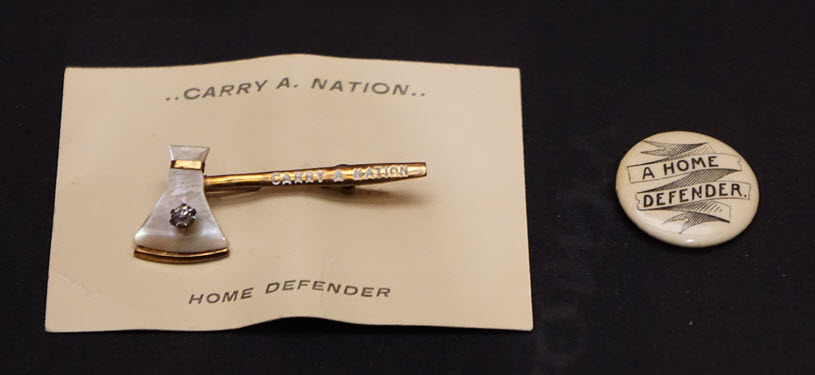

While Nation was speaking on the street in Topeka in 1901, a man ran from a candy store and handed her several small pewter hatchets. He suggested, “Sell them to this crowd and you can pay your costs and fines this month.” The crowd quickly snatched them up.
Buttons and pins like the one pictured at bottom were sold at temperance meetings to raise funds for the cause.
Think you know your history? Play the “Carry A. Nation Game” from the Kansas Historical Society
Test your knowledge of Carry A. Nation, a famous Kansan. She worked to support the prohibition laws that banned the sale of alcohol. She was tireless in her efforts, and traveled around the country, Canada, and the British Isles to “Carry A. Nation” to reform.
- In what state was Carry A. Nation born?
- What is the correct spelling of her first name?
- Which statement is false? She was orphaned at age two/She had one daughter/She nursed wounded soldiers/She married twice
- With what was Carry Nation was often photographed?
- Carry Nation smashed saloons in all but this town.
- Which newspaper editor bailed Carry Nation out of jail?
Visit the Kansas Historical Society site here for the answers. Good luck!
References
Last Call – The rise and fall of prohibition by Daniel Okrent. Scribner Inc, 2010
The Day Book (Chicago, Ill.), 1911-1917, November 02, 1915 – LOC
The St. Louis Republic, January 27, 1901 – LOC
Omaha Daily Bee, February 10, 1901 – LOC


